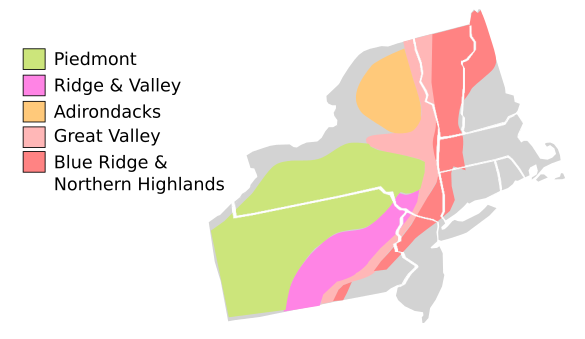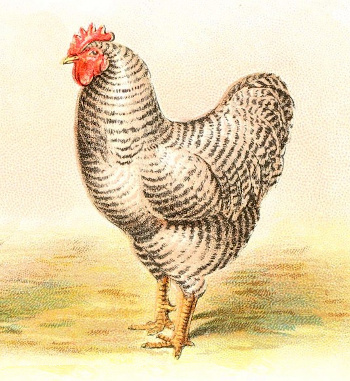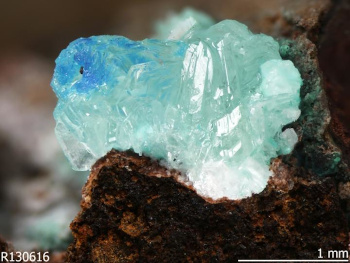Anthropocene Minerals
August 16, 2021
Tikalon's location on
Northern New Jersey is a
geologically interesting place.
Route 80, an
interstate highway, is just a
mile from my
house, and this highway was cut through
terrain that reveals the
sedimentary layers laid down through the
ages. These are quite apparent at the
Delaware Water Gap at the
border between
New Jersey and
Pennsylvania. Sedimentary layers there are from the
Silurian (443.8-419.2 million years ago) and
Ordovician (485.4-443.8 million years ago)
geological periods. The
fossil fauna record of the Silurian consists of mostly
marine animals, and a few small
terrestrial animals, such as the
millipede,
Pneumodesmus.

Geological regions of the Great Appalachian Valley. highway excavation through these areas reveal the sedimentary layers of the Silurian and Ordovician geological periods. (Created using Inkscape from a Wikimedia Commons map of the United States by Elli and a Wikimedia Commons map of the Appalachian Mountain physiographic regions by Perhelion. Click for larger image.)
Nicholas Steno, a
Catholic priest, initiated the
science of
stratigraphy in his
Dissertationis prodromusa, a 1669
treatise on the fossilization of
organic remains in sedimentary layers. He noted that
each horizontal layer records a particular period of time. The idea that
strata, the layers one atop another at
Earth's surface, contain a record of Earth's history was more completely developed in the
18th century.
William Smith (1769-1839) studied strata and their fossil markers to create the first geologic
map of
England.
Along with the fossil record of the development of
life on Earth, strata also contain evidence of global
catastrophes, such as the
extinction of the
dinosaurs by a
meteor impact about 65 million years ago. The is evidenced by an excess of
iridium in a
clay layer at the
boundary between the Cretaceous and Tertiary strata.[1-2] Iridium is a rare
element existing as just 0.001
ppm by
weight in
Earth's crust, which is forty times less of an abundance than
gold. The clay layer has a
concentration of iridium that's two
orders of magnitude greater than this, which is consistent with a meteor source.[1-2]
If the impact of
this 10 kilometer meteor is so easily seen in the geological strata, what of the affect of
human technology?
Geologists have struggled since the turn of
this century to define a definite geological starting point for the
Anthropocene, the period defined by significant human impact on the geology and
ecosystems of the Earth.[3-5] It's readily apparent that present conditions differ greatly from those of the
Holocene, the geological period begun 11,700 years ago in which we live.[3] At this writing, neither of the two major geological
organizations, the
International Commission on Stratigraphy and the
International Union of Geological Sciences, have an official definition for the Anthropocene.
An
Anthropocene Working Group of the
International Commission on Stratigraphy is considering potential stratigraphic markers for a
mid-twentieth century start of the Anthropocene. The mid-twentieth century was a time of dramatic
socioeconomic and
environmental changes, called the
Great Acceleration, which includes the
Atomic Age. Other proposed starting points of the Anthropocene include the beginning of the
Agricultural Revolution, 12,000–15,000 years ago.
Nobel Laureate,
Paul Crutzen, who originated the Anthropocene term, proposed its beginning in the late
18th century with the commencement of the
Industrial Revolution. My favorite marker of the Anthropocene is the
husbandry of
chickens.[6] Chickens have been a considerable accelerant of
civilization.

The husbandry of chickens, which are an easily raised source of meat with the added benefit of eggs, did much to advance civilization. Americans eat nearly a hundred pounds of chicken annually, which is more than pork or beef.
Chicken's mild taste is a perfect vehicle for culinary art, producing varied offering from chicken tikka masala to Kentucky Fried Chicken.
The wild progenitor of our domestic chicken is the red junglefowl (Gallus gallus). Charles Darwin made this determination, which has been confirmed by DNA analysis.
(Portion of a Wikimedia Commons image.)
Some argue that the Anthropocene should encompass the full span of human existence dating long before agriculture.[3] However, geological markers should be easily discovered, and modern technology has produced many geological
artifacts. As
University of Leicester (Leicester, UK) geologist,
Jan Zalasiewicz, explains, "The greatest changes, of
population,
industrialization,
globalization have taken place with the 'Great Acceleration' of the boom
post-WWII years of the mid-20th century."[4] His Leicester
colleague,
Mark Williams, remarks that "In that brief spell--a little less than one
average human lifetime--humanity has burned through more
energy than in the previous 12
millennia and more."[4] Humans are driving the
physical,
chemical and
biological changes that are
destabilizing the
biosphere and
climate, and the modern-day strata contains
plastics,
concrete and
supermarket chicken
bones that act as easy markers for the Anthropocene."[4]
One
research team has quantified some processes affected by human activity, as shown in Table I.[5]
Table I. The Anthropocene by the numbers.
Ratios of process outcomes, human/natural causes. Data from fig. 2 of Ref. 5.[5]
In 2017,
Robert M. Hazen of the Geophysical Laboratory of the
Carnegie Institution for Science (Washington, D.C.),
Edward S. Grew of the
University of Maine (Orono, Maine), along with
Marcus J. Origlieri and
Robert T. Downs of the
University of Arizona (Tucson, Arizona) published a different way to identify the Anthropocene.[7-8] They argue that
mining and
manufacturing operations since the industrial revolution have caused a spike in the diversity and distribution of mineral-like
compounds.[8] They
cataloged 208 mineral species that occur principally or exclusively as a result of human activity.[7-8] This number is more than 3.5% of the 5700 minerals officially recognized by the
International Mineralogical Association.[8-9]
As Hazen explains,
"Mineral evolution has continued throughout Earth's history. It has taken 4.5 billion years for combinations of elements to meet naturally on Earth at a specific location, depth and temperature, and to form into the more than 5,200 minerals officially recognized today... Within that collection of 5,200 are 208 minerals produced directly or indirectly by human activities, mostly since the mid-1700s, and we believe that others continue to be formed at that same relatively blazing pace. To imagine 250 years relative to 2 billion years, that's the difference between the blink of an eye (one third of a second) and one month."[8]
The research team identified three major types of human activities that have affected the stratigraphic mineral record. The first, and most obvious factor is the inclusion of many
synthetic minerals, such as
yttrium aluminum garnet (YAG) crystals for lasers,
silicon and other
semiconductors,
Portland cement,
carbide abrasives, and specialty
magnetic alloys such as
neodymium iron boride.[8] Second is the large-scale movements of rocks and sediments from their original location for things such as
road construction in a manner that's much faster than the natural redistribution caused by
glaciers.[8]

Simonkolleite, one of 208 anthropogenic minerals.
Simonkolleite [Zn5(OH)8Cl2·H2O] is a copper mining artifact, found in the Rowley mine, Maricopa County, Arizona.
(Photo credit: RRUFF Project. Click for larger image.)
The third human activity apparent in the recent stratigraphic mineral record is the human redistribution of select natural minerals, such as the
gemstones,
diamond,
ruby,
emerald, and
sapphire, along with concentrations of
gold,
silver, and
platinum.[8] Mineral collections juxtapose mineral species in unnatural combination.[8] As study co-author, Marcus Origlieri of the University of Arizona summarizes,
"In the sediment layers left behind from our age, future mineralogists will find plentiful building materials such as bricks, cinder blocks, and cement, metal alloys such as steel, titanium, and aluminum, along with many lethal radioactive byproducts of the nuclear age. They might also marvel at some beautiful manufactured gemstones, like cubic zirconia, moissanite, synthetic rubies, and many others."[8]
References:
- Luis W. Alvarez, Walter Alvarez, Frank Asaro, and Helen V. Michel, "Extraterrestrial Cause for the Cretaceous-Tertiary Extinction," Science, vol. 208, no. 4448 (June 6, 1980), pp. 1095-1108, DOI: 10.1126/science.208.4448.1095. A PDF copy of this paper can be found here.
- Luis W. Alvarez, "Experimental evidence that an asteroid impact led to the extinction of many species 65 million years ago," Proc. Natl. Acad. Sci., vol. 80, no. 2 (January 15, 1983), pp. 627-642. A PDF copy of this paper can be found here.
- Jan Zalasiewicz, Colin N. Waters, Erle C. Ellis, Martin J. Head, Davor Vidas, Will Steffen, Julia Adeney Thomas, Eva Horn, Colin P. Summerhayes, Reinhold Leinfelder, J. R. McNeill, Agnieszka Gałuszka, Mark Williams, Anthony D. Barnosky, Daniel de B. Richter. Philip L. Gibbard, Jaia Syvitski, Catherine Jeandel, Alejandro Cearreta, Andrew B. Cundy, Ian J. Fairchild, Neil L. Rose, Juliana A. Ivar do Sul, William Shotyk, Simon Turner. Michael Wagreich, and Jens Zinke, "The Anthropocene: Comparing Its Meaning in Geology (Chronostratigraphy) with Conceptual Approaches Arising in Other Disciplines," Earth's Future, vol. 9, no. 3 (March, 2021), https://doi.org/10.1029/2020EF001896. This is an open access article with a PDF file here.
- How many Anthropocenes, University of Leicester Press Release, April 10, 2021.
- Griffin Chure, Rachel A. Banks, Avi I. Flamholz, Nicholas S. Sarai, Mason Kamb, Ignacio Lopez-Gomez, Yinon M. Bar-On, Ron Milo, and Rob Phillips, "The Anthropocene by the Numbers: A Quantitative Snapshot of Humanity's Influence on the Planet," arXiv, January 24, 2021.
- Chickens to be marker of Anthropocene, University of Leicester Press Release, December 12, 2018.
- Robert M. Hazen, Edward S. Grew, Marcus J. Origlieri, and Robert T. Downs, "On the mineralogy of the 'Anthropocene Epoch'," American Mineralogist: Journal of Earth and Planetary Materials, vol. 102, no. 3 (March, 2017), pp. 595-611.
- Catalog of 208 human-caused minerals bolsters argument to declare 'Anthropocene Epoch', Carnegie Science and the Deep Carbon Observatory Press Release, March 1, 2017.
- IMA Database of Mineral Properties, RRUFF Project in partnership with the International Mineralogical Association.
Permanent Link to this article
Linked Keywords: Tikalon; Northern New Jersey; geology; geological; Interstate 80; Route 80; Interstate Highway System; mile; home; house; terrain; sedimentary rock; sedimentary layer; geologic time scale; age; Delaware Water Gap; border; New Jersey; Pennsylvania; Silurian; Ordovician; geological period; fossil; fauna; marine life; marine animal; terrestrial animal; millipede; Pneumodesmus; geological region; Great Appalachian Valley; highway; digging; excavation; Inkscape; Wikimedia Commons; Perhelion; Nicholas Steno; Catholic priest; science; stratum; stratigraphy; treatise; organic matter; principle of original horizontality; strata; lithosphere; Earth's surface; 18th century; William Smith (1769-1839); map; England; organism; life on Earth; disaster; catastrophe; extinction; dinosaur; impact event; meteor impact; iridium; clay; boundary between the Cretaceous and Tertiary strata; chemical element; parts-per notation; ppm; weight; Earth's crust; gold; concentration; orders of magnitude; Chicxulub impactor; 10 kilometer meteor; human; technology; geologists; 21st century; Anthropocene; ecosystem; Holocene; professional association; International Commission on Stratigraphy; International Union of Geological Sciences; Anthropocene Working Group; mid-twentieth century; socioeconomic; environment (biophysical); environmental; Great Acceleration; Atomic Age; Agricultural Revolution; Nobel laureate in Chemistry; Paul Crutzen; 18th century; Industrial Revolution; animal husbandry; chicken; civilization; meat; egg (food); American; eating; eat; pound (mass); annually; pork; beef; taste; culinary art; chicken tikka masala; Kentucky Fried Chicken; wildlife; wild; progenitor; domesticated animal; domestic; red junglefowl (Gallus gallus); Charles Darwin; genetic testing; DNA analysis; artifact (archaeology); University of Leicester (Leicester, UK); Jan Zalasiewicz; world population; industry; industrialization; globalization; World War II; colleague; Mark William; life expectancy; average human lifetime; energy; millennium; millennia; physics; physical; hemistry; chemical; biology; biological; ecological stability; destabilizing; biosphere; climate; plastic; concrete; supermarket; bone; research; ratio; deforestation; forest; wildfire; mass; livestock; barnyard animal; wildlife; wild animal; heavy equipment; earth moving; soil; earth; river; carbon dioxide; CO2; methane; CH4; extinction; Robert M. Hazen; Carnegie Institution for Science (Washington, D.C.); Edward S. Grew; University of Maine (Orono, Maine); Marcus J. Origlieri; Robert T. Downs; University of Arizona (Tucson, Arizona); mining; manufacturing; chemical compound; cataloged; International Mineralogical Association; chemical element; temperature; blinking; blink of an eye; second; month; chemical synthesis; synthetic; yttrium aluminum garnet (YAG); active laser medium; crystals for lasers; silicon; semiconductor; Portland cement; carbide; abrasive; magnetic alloy; neodymium magnet; neodymium iron boride; road construction; glacier; Zinc chloride hydroxide monohydrate; Simonkolleite; human impact on the environment; anthropogenic; mineral; copper; mining; Maricopa County, Arizona; RRUFF Project; gemstone; diamond; ruby; emerald; sapphire; gold; silver; platinum; brick; concrete masonry unit; cinder block; metal alloy; steel; titanium; aluminum; lethality; lethal; radioactive decay; radioactive; byproduct; Atomic Age; nuclear age; cubic zirconia; moissanite.